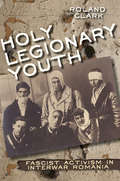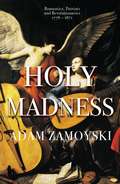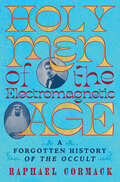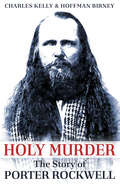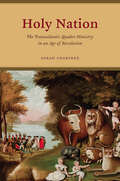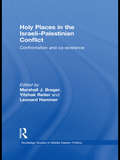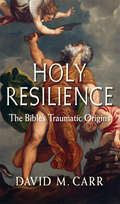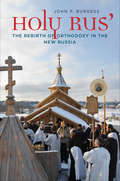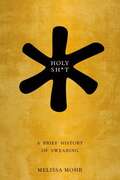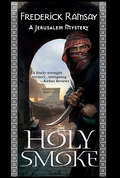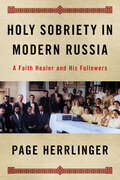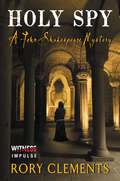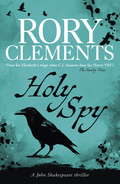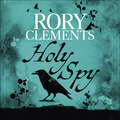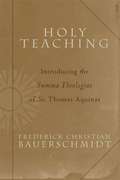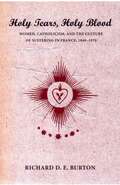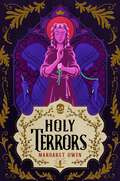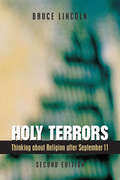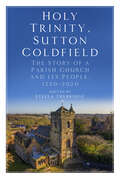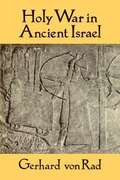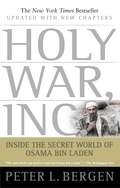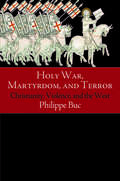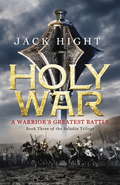- Table View
- List View
Holy Legionary Youth: Fascist Activism in Interwar Romania
by Roland ClarkFounded in 1927, Romania’s Legion of the Archangel Michael was one of Europe’s largest and longest-lived fascist social movements. In Holy Legionary Youth, Roland Clark draws on oral histories, memoirs, and substantial research in the archives of the Romanian secret police to provide the most comprehensive account of the Legion in English to date. Clark approaches Romanian fascism by asking what membership in the Legion meant to young Romanian men and women. Viewing fascism “from below,” as a social category that had practical consequences for those who embraced it, he shows how the personal significance of fascism emerged out of Legionaries’ interactions with each other, the state, other political parties, families and friends, and fascist groups abroad. Official repression, fascist spectacle, and the frequency and nature of legionary activities changed a person’s everyday activities and relationships in profound ways. Clark’s sweeping history traces fascist organizing in interwar Romania to nineteenth-century grassroots nationalist movements that demanded political independence from the Austro-Hungarian Empire. It also shows how closely the movement was associated with the Romanian Orthodox Church and how the uniforms, marches, and rituals were inspired by the muscular, martial aesthetic of fascism elsewhere in Europe. Although antisemitism was a key feature of official fascist ideology, state violence against Legionaries rather than the extensive fascist violence against Jews had a far greater impact on how Romanians viewed the movement and their role in it. Approaching fascism in interwar Romania as an everyday practice, Holy Legionary Youth offers a new perspective on European fascism, highlighting how ordinary people “performed” fascism by working together to promote a unique and totalizing social identity.
Holy Madness: Romantics, Patriots And Revolutionaries 1776-1871
by Adam ZamoyskiFrom America's fight for independence to the Paris Commune - an exotic collection of fanatics, adventurers, poets and thinkers are brought vividly to life.Holy Madness probes into the psyche that was responsible for so many of the founding events of our modern world, and into the instincts that inspired its most generous and most murderous impulses. It explains how the Enlightenment dislodged Christianity from its central position in the life of European societies and how man's quest for ecstasy and transcendence flooded into areas such as the arts, spawning the Romantic movement. This dramatic journey which begins in America in 1776 and goes right up to the last agony of the Paris Commune in 1871, takes in the French revolution, the Irish rebellion, the Polish risings, the war of Greek liberation, the Russian insurrection, the Hungarian struggles for freedom, the liberation of South America, and the Italian Risorgimento.'An ambitious and in many ways brilliant book' Hilary Mantel
Holy Matter: Changing Perceptions of the Material World in Late Medieval Christianity
by Sara RitcheyA magnificent proliferation of new Christ-centered devotional practices—including affective meditation, imitative suffering, crusade, Eucharistic cults and miracles, passion drama, and liturgical performance—reveals profound changes in the Western Christian temperament of the twelfth century and beyond. This change has often been attributed by scholars to an increasing emphasis on God’s embodiment in the incarnation and crucifixion of Christ. In Holy Matter, Sara Ritchey offers a fresh narrative explaining theological and devotional change by journeying beyond the human body to ask how religious men and women understood the effects of God’s incarnation on the natural, material world. She finds a remarkable willingness on the part of medieval Christians to embrace the material world—its trees, flowers, vines, its worms and wolves—as a locus for divine encounter.Early signs that perceptions of the material world were shifting can be seen in reformed communities of religious women in the twelfth-century Rhineland. Here Ritchey finds that, in response to the constraints of gendered regulations and spiritual ideals, women created new identities as virgins who, like the mother of Christ, impelled the world’s re-creation—their notion of the world’s re-creation held that God created the world a second time when Christ was born. In this second act of creation God was seen to be present in the physical world, thus making matter holy. Ritchey then traces the diffusion of this new religious doctrine beyond the Rhineland, showing the profound impact it had on both women and men in professed religious life, especially Franciscans in Italy and Carthusians in England. Drawing on a wide range of sources including art, liturgy, prayer, poetry, meditative guides, and treatises of spiritual instruction, Holy Matter reveals an important transformation in late medieval devotional practice, a shift from metaphor to material, from gazing on images of a God made visible in the splendor of natural beauty to looking at the natural world itself, and finding there God’s presence and promise of salvation.
Holy Men of the Electromagnetic Age: A Forgotten History of the Occult
by Raphael CormackAn international history of the uncanny in the 1920s and 1930s. The interwar period was a golden age for the occult. Spiritualists, clairvoyants, fakirs, Theosophists, mind readers, and Jinn summoners all set out to assure the masses that just as newly discovered invisible forces of electricity and magnetism determined the world of science, unseen powers commanded an unknown realm of human potential Drawing on untapped sources in Arabic in addition to European ones, Raphael Cormack follows two of the most unusual and charismatic figures of this age: Tahra Bey, who took 1920s Paris by storm in the role of a missionary from the mystical East; and Dr. Dahesh, who transformed Western science to create a panreligious faith of his own in Lebanon. Traveling between Paris, New York, and Beirut while guiding esoteric apprenticeships among miracle-working mystics in Egypt and Istanbul, these men reflected the desires and anxieties of a troubled age. As Cormack demonstrates, these forgotten holy men, who embodied the allure of the unexplained in a world of dramatic change, intuitively speak to our unsettling world today
Holy Murder: The Story of Porter Rockwell
by Charles Kelly Birney HoffmanHoly Murder, first published in 1934, is a fascinating, controversial look at the “Avenging Angel” of the Mormon Church, Porter Rockwell. The authors trace the violent history of the Mormon Church beginning with its origins in New York and Illinois, to the flight of its members and their settlement near the Great Salt Lake. Citing numerous sources and interviewing witnesses and descendants, the exploits of Rockwell are detailed to form a picture of a man on the one hand kind to children and his friends, while on the other capable of the most grisly murders of perceived enemies of the church. Although open to criticism for its anti-Mormon bias, attempting to accurately portray Rockwell is difficult as he did not keep a personal diary and many of his activities were shrouded in secrecy. Included are 12 pages of illustrations.
Holy Nation: The Transatlantic Quaker Ministry in an Age of Revolution (American Beginnings, 1500–1900)
by Sarah CrabtreeEarly American Quakers have long been perceived as retiring separatists, but in Holy Nation Sarah Crabtree transforms our historical understanding of the sect by drawing on the sermons, diaries, and correspondence of Quakers themselves. Situating Quakerism within the larger intellectual and religious undercurrents of the Atlantic World, Crabtree shows how Quakers forged a paradoxical sense of their place in the world as militant warriors fighting for peace. She argues that during the turbulent Age of Revolution and Reaction, the Religious Society of Friends forged a “holy nation,” a transnational community of like-minded believers committed first and foremost to divine law and to one another. Declaring themselves citizens of their own nation served to underscore the decidedly unholy nature of the nation-state, worldly governments, and profane laws. As a result, campaigns of persecution against the Friends escalated as those in power moved to declare Quakers aliens and traitors to their home countries.Holy Nation convincingly shows that ideals and actions were inseparable for the Society of Friends, yielding an account of Quakerism that is simultaneously a history of the faith and its adherents and a history of its confrontations with the wider world. Ultimately, Crabtree argues, the conflicts experienced between obligations of church and state that Quakers faced can illuminate similar contemporary struggles.
Holy Places in the Israeli-Palestinian Conflict: Confrontation and Co-existence (Routledge Studies in Middle Eastern Politics)
by Yitzhak Reiter Marshall J. Breger Leonard HammerThis book addresses the major generators of conflict and toleration at shared holy places in Palestine and Israel. Examining the religious, political and legal issues, the authors show how the holy sites have been a focus of both conflict and cooperation between different communities. Bringing together the views of a diverse group of experts on the region, Holy Places in the Israeli-Palestinian Conflict provides a new and multifaceted approach to holy places, giving an in-depth analysis of relevant issues. Themes covered include legal regulation of holy places; nationalization and reproduction of holy space; sharing and contesting holy places; identity politics; and popular legends of holy sites. Chapters cover in detail how recognition and authorization of a new site come about; the influence of religious belief versus political ideology on the designation of holy places; the centrality of such areas to the surrounding political developments; and how historical background and culture affect the perception of a holy site and relations between conflicting groups. This new approach to the study of holy places and the Israeli-Palestinian conflict has great significance for a variety of disciplines, and will be of great interest in the fields of law, politics, religious studies, anthropology and sociology.
Holy Resilience
by David M. CarrHuman trauma gave birth to the Bible, suggests eminent religious scholar David Carr. The Bible’s ability to speak to suffering is a major reason why the sacred texts of Judaism and Christianity have retained their relevance for thousands of years. In his fascinating and provocative reinterpretation of the Bible’s origins, the author tells the story of how the Jewish people and Christian community had to adapt to survive multiple catastrophes and how their holy scriptures both reflected and reinforced each religion’s resilient nature. Carr’s thought-provoking analysis demonstrates how many of the central tenets of biblical religion, including monotheism and the idea of suffering as God’s retribution, are factors that provided Judaism and Christianity with the strength and flexibility to endure in the face of disaster. In addition, the author explains how the Jewish Bible was deeply shaped by the Jewish exile in Babylon, an event that it rarely describes, and how the Christian Bible was likewise shaped by the unspeakable shame of having a crucified savior.
Holy Rus': The Rebirth of Orthodoxy in the New Russia
by John P. BurgessA fascinating, vivid, and on-the-ground account of Russian Orthodoxy's resurgence A bold experiment is taking place in Russia. After a century of being scarred by militant, atheistic communism, the Orthodox Church has become Russia's largest and most significant nongovernmental organization. As it has returned to life, it has pursued a vision of reclaiming Holy Rus': that historical yet mythical homeland of the eastern Slavic peoples; a foretaste of the perfect justice, peace, harmony, and beauty for which religious believers long; and the glimpse of heaven on earth that persuaded Prince Vladimir to accept Orthodox baptism in Crimea in A. D. 988. Through groundbreaking initiatives in religious education, social ministry, historical commemoration, and parish life, the Orthodox Church is seeking to shape a new, post-communist national identity for Russia. In this eye-opening and evocative book, John Burgess examines Russian Orthodoxy's resurgence from a grassroots level, providing Western readers with an enlightening, inside look at the new Russia.
Holy Sh*t: A Brief History of Swearing
by Melissa MohrDetermining what is obscene is a timeless preoccupation, nearly as timeless as the search for words that adequately express a relationship with the divine. As Melissa Mohr shows in this imaginative and illuminating tour through linguistic history, those preoccupations are not separate. "Swearing" is what we do when we forge a bond with a higher authority, as when we tell the truth and nothing but the truth; it is also what we do to break that bond. In both cases, certain words are endowed with the power to shock or to awe. Obscenities tend toward the earthy and generally remind us that we have bodies. Oaths are lifted to heaven and serve to remind us that we have souls. Holy Sh*t brilliantly and entertainingly investigates these two kinds of swearing--obscenities and oaths--from ancient Rome and the Bible to the present, uncovering the history of sacred and profane language in English through the ages. It is a journey with a number of surprises. Obscenities in ancient Rome were remarkably similar to our own; George Carlin would have felt completely at home. With the rise of the Church came a new sense of how language should be used, or not--and the difference was often a matter of life and death. Holy Sh*t tracks the advancement of civility and corresponding censorship of language in the eighteenth century; considers the rise of racial slurs after World War II; examines the physiological effects of swearing (increased heart rate and greater pain tolerance); and answers a question that preoccupies the FCC, the U.S. Senate, and anyone who has lately visited a junior high school: are we swearing more now than people did in the past? A gem of lexicography and cultural history, Holy Sh*t is a serious exploration of linguistic totem and taboo. It charts the way swearing has changed over the centuries, and considers the cultural concerns that gave way to those changes. By looking at the words that have expressed our deepest emotions, high and low, Holy Sh*t reveals the shifting relationship between the divine and the dirty. MELISSA MOHR has recently been dividing her time between writing this book about swearing, and hiding it from her kids. She received a Ph.D. in English literature from Stanford University, specializing in Medieval and Renaissance literature. She lives in Somerville, Massachusetts.
Holy Smoke: A Jerusalem Mystery (large Print 16pt) (Jerusalem Mysteries #2)
by Frederick RamsayThe year is 29 C.E., and Jerusalem chafes under the Roman Empire's oppressive rule. A badly scorched body is found behind the Veil of the Holy of Holies—the Temple's inner sanctum, the most sacred space on earth for the Jews. No one except the high priest may enter this place and he only on the Day of Atonement. This is no casual violation, and the authorities are in an uproar.Gamaliel, the rabban of the Sanhedrin, is the ranking rabbi in all of Judea. Now he must solve this delicate mystery while dark agents with unholy interests plot to seize control of much of the trade in certain highly profitable imports. As the tangled web of intrigue and murder is slowly unraveled, Yeshua, the radical rabbi from Galilee, continues to annoy the high priest, and holy smoke from the sacrifices rises from the Temple.
Holy Sobriety in Modern Russia: A Faith Healer and His Followers (NIU Series in Slavic, East European, and Eurasian Studies)
by Page HerrlingerDrawing on multiple archives and primary sources, including secret police files and samizdat, Holy Sobriety in Modern Russia reconstructs the history of a spiritual movement that survived persecution by the Orthodox church and decades of official atheism, and still exists today. Since 1894, tens of thousands of Russians have found hope and faith through the teachings and prayers of the charismatic lay preacher and healer, Brother Ioann Churikov (1861–1933). Inspired by Churikov's deep piety, "miraculous" healing ability, and scripture-based philosophy known as holy sobriety, the "trezvenniki"—or "sober ones"—reclaimed their lives from the effects of alcoholism, unemployment, domestic abuse, and illness. Page Herrlinger examines the lived religious experience and official repression of this primarily working-class community over the span of Russia's tumultuous twentieth century, crossing over—and challenging—the traditional divide between religious and secular studies of Russia and the Soviet Union, and highlighting previously unseen patterns of change and continuity between Russia's tsarist and socialist pasts. This grass-roots faith community makes an ideal case study through which to explore patterns of spiritual searching and religious toleration under both tsarist and Soviet rule, providing a deeper context for today's discussions about the relationship between Russian Orthodoxy and national identity. Holy Sobriety in Modern Russia is a story of resilience, reinvention, and resistance. Herrlinger's analysis seeks to understand these unorthodox believers as active agents exercising their perceived right to live according to their beliefs, both as individuals and as a community.
Holy Spy
by Rory ClementsFor fans of CJ Sansom and SJ Parris, Holy Spy features the Queen's Intelligencer John Shakespeare in the latest of Rory Clements's acclaimed and bestselling series of Tudor spy thrillersIn London's smoky taverns, a conspiracy is brewing: a group of wealthy young Catholic dissidents plot to assassinate Elizabeth, free Mary Queen of Scots--and open England to Spanish invasion. But the conspirators have been infiltrated by Sir Francis Walsingham's top intelligencer, John Shakespeare.Shakespeare, however, is torn: the woman he loves stands accused of murder. In a desperate race against time he must save her from the noose and the realm from treachery. And then it dawns that both investigations are inextricably linked--by corruption very close to the seat of power...Published by William Morrow
Holy Spy: John Shakespeare 6 (John Shakespeare #7)
by Rory Clements*****Part of the bestselling John Shakespeare series of Tudor spy thrillers from Rory Clements, winner of the Ellis Peters Historical Fiction Award*****'[Clements] does for Elizabeth's reign what CJ Sansom does for Henry VIII's' Sunday Times**********In London's smoky taverns, a conspiracy is brewing: a group of wealthy young Catholic dissidents plot to assassinate Elizabeth, free Mary Queen of Scots - and open England to Spanish invasion. But the conspirators have been infiltrated by Sir Francis Walsingham's top intelligencer, John Shakespeare.Shakespeare, however, is torn: the woman he loves stands accused of murder. In a desperate race against time he must save her from the noose and the realm from treachery. And then it dawns that both investigations are inextricably linked - by corruption very close to the seat of power . . .
Holy Spy: John Shakespeare 6 (John Shakespeare #7)
by Rory ClementsFor fans of C J Sansom and S J Parris, HOLY SPY features the Queen's Intelligencer John Shakespeare in the latest of Rory Clements' acclaimed and bestselling series of Tudor spy thrillers. Clements, winner of the Ellis Peters Historical Fiction Award, 'does for Elizabeth's reign what C.J. Sansom does for Henry VIII's' Sunday TimesIn London's smoky taverns, a conspiracy is brewing: a group of wealthy young Catholic dissidents plot to assassinate Elizabeth, free Mary Queen of Scots - and open England to Spanish invasion. But the conspirators have been infiltrated by Sir Francis Walsingham's top intelligencer, John Shakespeare.Shakespeare, however, is torn: the woman he loves stands accused of murder. In a desperate race against time he must save her from the noose and the realm from treachery. And then it dawns that both investigations are inextricably linked - by corruption very close to the seat of power . . .(P)2015 Hodder & Stoughton
Holy Spy: John Shakespeare 6 (John Shakespeare #7)
by Rory Clements*****Part of the bestselling John Shakespeare series of Tudor spy thrillers from Rory Clements, winner of the Ellis Peters Historical Fiction Award*****'[Clements] does for Elizabeth's reign what CJ Sansom does for Henry VIII's' Sunday Times**********In London's smoky taverns, a conspiracy is brewing: a group of wealthy young Catholic dissidents plot to assassinate Elizabeth, free Mary Queen of Scots - and open England to Spanish invasion. But the conspirators have been infiltrated by Sir Francis Walsingham's top intelligencer, John Shakespeare.Shakespeare, however, is torn: the woman he loves stands accused of murder. In a desperate race against time he must save her from the noose and the realm from treachery. And then it dawns that both investigations are inextricably linked - by corruption very close to the seat of power . . .
Holy Teaching: Introducing the Summa Theologiae of St. Thomas Aquinas
by Kenneth W. Thomas Frederick Christian BauerschmidtA book that offers an introduction to Thomas Aquinas with selections from the Summa Theologiae and explanatory commentary.
Holy Tears, Holy Blood: Women, Catholicism, and the Culture of Suffering in France, 1840–1970
by Richard D. E. BurtonIn Holy Tears, Holy Blood, Richard D. E. Burton continues his investigation of Catholic France from Revolution to Liberation. From his focus in Blood in the City on public demonstrations of the cultural power of Catholicism, he now turns to more private rituals, those codes of conduct that shaped the interior lives of French Catholic women and determined their artistic and social presentation. "Here there is rather less blood, and considerably more weeping," Burton says. In portraits of eleven women, including Simone Weil and Sainte Thèrése, he traces the lasting power of particular expressions of suffering and sacrifice. How, Burton asks, does a rapidly modernizing society accommodate the cultural-historical legacy of religious belief, in particular the extreme conservative beliefs of ultramontane Catholicism? Burton pays particular attention to the doctrine of "vicarious suffering," whereby an individual suffers for the redemption of others, and to certain extreme forms of religious experience including stigmatization, self-starvation, visions, and apparitions.
Holy Terrors (Little Thieves)
by Margaret OwenIt has been almost two years since she defeated the vengeful spirit of her mother, but Vanja Ros - no longer Schmidt - has finally made a name for herself. She is a God Daughter, a (reformed) thief, and now a folk hero. She stands up for those with nothing, bringing justice and prosperity where she can.But members of the royal families are turning up dead, found with Vanja's calling card on the bodies. And as old flames, adversaries, and allies resurface, Vanja must face what it took to become the Pfennigist once and for all.It will take everything she is to save not only herself and the people she loves, but time as we know it.
Holy Terrors: Thinking about Religion after September 11
by Bruce LincolnIt is tempting to regard the perpetrators of the September 11th terrorist attacks as evil incarnate. But their motives, as Bruce Lincoln's acclaimed Holy Terrors makes clear, were profoundly and intensely religious. Thus what we need after the events of 9/11, Lincoln argues, is greater clarity about what we take religion to be.
Holy Trinity, Sutton Coldfield: The Story of a Parish Church and its People, 1250-2020
by Stella ThebridgeFor the first time in its 750-year existence, a full history of Holy Trinity is available to the general public. One of only a small number of parish churches to be Grade I listed, Holy Trinity displays its rich heritage through stained glass, memorials, unique woodwork and glorious painted ceilings. It also houses the tomb of Sutton Coldfield’s most famous son, John Vesey, Bishop of Exeter, whose work for the benefit of both church and town, with the blessing of King Henry VIII, continues to earn him the respect of the local community in every generation. Funding from the Heritage Lottery Fund in 2017-19 has enabled this book to be researched and written. The timing of its publication enables the history to be as up-to-date as possible, following on from a major reordering of the church interior to create a space for church and community fit for the 21st century.
Holy War in Ancient Israel
by Gerhard Von RadTranslation of Der Heilige Krieg im alten Israel from German into English.
Holy War, Inc.: Inside the Secret World of Osama Bin Laden
by Peter L. BergenOn September 11, 2001, the world in which we live was changed forever. The twin towers of the World Trade Center came crashing down, one side of the Pentagon burst into flame, and more than six thousand men, women, and children lost their lives in the most deadly terrorist attack on American soil. As shocking as it was, it had been long in the making: The assault was the most sophisticated and horrifying in a series of operations masterminded by Osama bin Laden and his Jihad group -- an organization that CNN's terrorism analyst Peter Bergen calls Holy War, Inc. One of only a handful of Western journalists to have interviewed the world's most wanted man face to face, Peter Bergen has produced the definitive book on the Jihadist network that operates globally and in secrecy. In the course of four years of investigative reporting, he has interviewed scores of insiders -- from bin Laden associates and family members to Taliban leaders to CIA officials -- and traveled to Afghanistan, Yemen, Egypt, Pakistan, and the United Kingdom to learn the truth about bin Laden's al Queda organization and his mission. Immense in scope and unnerving in its findings,Holy War, Inc. reveals:How bin Laden lives, travels, and communicates with his "cells. " How his role in the crushing defeat of the Soviet Union in Afghanistan made him a hero to Muslims all over the world -- and equipped him to endure a long and bloody siege. How the CIA ended up funding -- to the tune of three billion dollars -- radical, anti-American Afghan groups allied to bin Laden. How the attacks that foreshadowed the destruction of the World Trade Center -- among them the bombings of the American embassies in Africa and the warship USSColein Yemen -- were planned and executed. The dimensions of bin Laden's personal fortune, and why freezing his assets is both futile and nearly impossible. The ideology of bin Laden's number two, the man who has influenced him most profoundly in his holy war -- the Egyptian Ayman al Zawahiri. What we can expect from Islamist extremists in the future. Above all, Peter Bergen helps us to see bin Laden's organization in a radically new light: as a veritable corporation that has exploited twenty-first-century communications and weapons technologies in the service of a medieval reading of the Koran and holy war. Holy War, Inc. is essential reading for anyone trying to understand tomorrow's terrorist threats and the militant Islamist movements that could determine the fate of governments -- and human lives -- the world over. Both author and publisher will donate a portion of the proceeds from this book to United Way's September 11th Fund for the relief of victims of the World Trade Center attacks.
Holy War, Martyrdom, and Terror: Christianity, Violence, and the West (Haney Foundation Series)
by Philippe BucHoly War, Martyrdom, and Terror examines the ways that Christian theology has shaped centuries of conflict from the Jewish-Roman War of late antiquity through the First Crusade, the French Revolution, and up to the Iraq War. By isolating one factor among the many forces that converge in war—the essential tenets of Christian theology—Philippe Buc locates continuities in major episodes of violence perpetrated over the course of two millennia. Even in secularized or explicitly non-Christian societies, such as the Soviet Union of the Stalinist purges, social and political projects are tied to religious violence, and religious conceptual structures have influenced the ways violence is imagined, inhibited, perceived, and perpetrated.The patterns that emerge from this sweeping history upend commonplace assumptions about historical violence, while contextualizing and explaining some of its peculiarities. Buc addresses the culturally sanctioned logic that might lead a sane person to kill or die on principle, traces the circuitous reasoning that permits contradictory political actions, such as coercing freedom or pardoning war atrocities, and locates religious faith at the backbone of nationalist conflict. He reflects on the contemporary American ideology of war—one that wages violence in the name of abstract notions such as liberty and world peace and that he reveals to be deeply rooted in biblical notions. A work of extraordinary breadth, Holy War, Martyrdom, and Terror connects the ancient past to the troubled present, showing how religious ideals of sacrifice and purification made violence meaningful throughout history.
Holy War: Book Three of the Saladin Trilogy
by Jack HightIn HOLY WAR, the final book of the Saladin Trilogy, telling the story of the legendary war leader who united Arabia, Saladin recaptures Jerusalem from the Crusaders, and prepares for his ultimate battle against Richard the Lionheart. A full-blooded historical adventure novel for all fans of Conn Iggulden, Bernard Cornwell, Anthony Riches, Ben Kane, Robyn Young and Simon Scarrow.While Saladin ruthlessly sets about uniting the whole of Arabia under his rule, the Kingdom of Jerusalem is torn apart by treachery and intrigue, and when the murderous knight Reynald of Chatillon raids a caravan heading from Damascus to Mecca and rapes Saladin's sister, the scene is set for war.In June 1187, Saladin marches into the Kingdom with an army of over 24,000 and imposes a crushing defeat on the Crusader forces at the Horns of Hattin. It is only a matter of time before he marches on a panicked and demoralized Jerusalem.But what about Saladin's longtime ally, the Saxon knight John of Tatewic? In the face of annihilation, is he friend or foe? It will take all John's knowledge of the man he calls his brother to negotiate a peaceful fate for Jerusalem - but this is not the end of the story. For in England the soon-to-be crowned King Richard has pledged revenge and a new Crusade . . .
